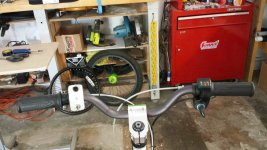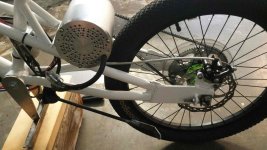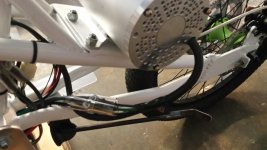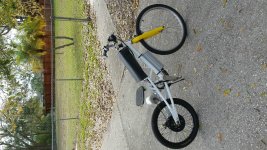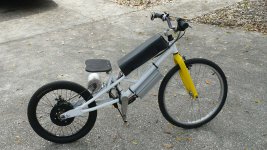Barncat said:Was able to zip around a bit yesterday afternoon for the maiden voyage of this project. Had to weld battery mount brackets and chain tensioners a few days ago so decided to do the paint job at same time.
<snip>
Suffered a big unforseen setback when the goddamn chain derailed on the inside of the rear sprocket today, which is why the wheel is off. Major PITA. Must build some chain guides for both sides of the 80T...
This is all stuff you may already know from your motorcycle experience, but I'll put it out there anyway:
Well, the frame looks plenty stiff, and the motor is very close to the wheel, so it's unliekly to be frame twisting causing the derailing (a common problem).
You mention a just-added chain tensioner but I can't see it in the pics, or a way I can see to adjust the chain tension or chainline. If you see chain "bounce" along the slack side of the chain while running, especially as torque changes, you probably need a tensioner (on the pull side) or a way to adjust tension by moving the motor forward / up.
If the chain (for that skinny size) is so tense that you can't even deflect it at all with your finger, it's too tight and will wear the chain, freewheel, sprockets, motor bearings, etc., much faster than it should.
If the freewheel has any wobble in it, it will also contribute to chain throwing--worse the larger diameter the sprocket is.
I can't tell if the chainline is perfectly straight or not; if it isn't, then that will contribute to chain throwing. If the derailments always happen on the same side of the sprocket, it's probably not a straight chainline, and the motor sprocket would need to be moved laterally in the direction opposite to the derailment by a tiny bit at a time until the rpoblem stops.
Also, #25 chain is not really known for it's torque-handling capabilities (or it's wear rate), since none of hte ones I've had actually had "rollers", only bushings); if you really want higher torque you might need a larger type of chain (though this means larger diameter sprockets for the same reduction, which probably means making your own large sprocket or paying quite a bit for a custom-made one
This issue we're covering over here:The throttle however is lurchy off zero throttle from a standing start even with a careful gradual twist. I hate that. I assume neither the throttle nor the controller is adjustable in my case. Opinions appreciated...
https://endless-sphere.com/forums/viewtopic.php?f=30&t=110234
so I'll respond there to that part.



